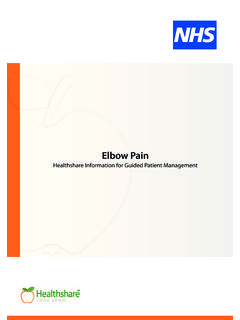Transcription of Shoulder Replacement Commonly Asked Questions
1 Shoulder Replacement Commonly Asked Questions Patrick J Denard, MD. 2780 E. Barnett Rd Medford, OR 97530. 541-779-6250. Background Information What is the anatomy of the Shoulder ? The Shoulder joint is very complex and involves three bones and more than one joint. These bones are the clavicle (collar bone), the scapula ( Shoulder blade), and the humerus (upper arm bone). Numerous muscles, ligaments, and tendons surround the joint (Figure). The upper end of the arm bone (humerus) and the outside edge of the scapula bone (glenoid) form a ball-and-socket joint . This joint is remarkable because it typically allows greater range of motion than any other joint in your body. Figure 1. When is a Shoulder Replacement needed? Shoulder Replacement surgery is most Commonly used for severe degenerative joint disease (osteoarthritis) of the ball-and-socket joint. When the smooth surfaces (cartilage).
2 Of the ball and socket become rough, they rub against each other rather than glide. This rubbing causes pain, stiffness and swelling. Most patients who decide to have Shoulder Replacement surgery have experienced Shoulder pain for a long time. Many patients have developed pain that limits their daily activities, as well as interferes with their sleep. Shoulder stiffness also interferes with the use of their arm for everyday activities. A. Shoulder Replacement is performed to alleviate Shoulder pain. It also helps to improve the range of motion of your Shoulder joint, which also improves your function and the quality of your life. What are the types of Replacement ? The two most common types of Shoulder Replacement are an anatomic Shoulder Replacement and a reverse total Shoulder Replacement . With an anatomic total Shoulder Replacement , the ball (humeral head) of the Shoulder joint is replaced with an implant that includes a stem with a smooth, rounded metal head.
3 The socket (glenoid) is replaced with a smooth, specialized plastic that is cemented into place. In essence the diseased cartilage is removed and resurfaced with the two components (Figure 2). In some cases just the ball is replaced, which is called a partial Replacement or hemiarthroplasty. With a reversed total Shoulder Replacement , the normal structure of the Shoulder is reversed. The ball portion of the implant isattached to the scapula (where the socketnormally is) and the artificial socket is attached to the humeral head (where the ball normally is) (Figure 3). This allows the stronger deltoid muscles of the Shoulder to takeover much of the work of moving the Shoulder , increasing joint stability. A reversed procedure is use for patients with a severely torn and compromised rotator cuff. It is also Commonly used in revision surgery cases. Figure 2. Anatomic Shoulder Replacement Figure 3.
4 Reverse Shoulder Replacement How successful is Shoulder Replacement ? In most cases Shoulder Replacement is very successful. Typically patients gain 50 degrees in forward elevation (raising the arm straight ahead). In other words most patients go from raising their arm at or below Shoulder level to being able to raise the arm above the Shoulder . Similarly, rotation out to the side improves on average by 30 degrees. Rotation behind the back also improves. The survival of the implant is 90 to 95% at 10 years after surgery and approximately 80% 20 years after How do the results of a complete Replacement compare to partial Replacement ? In partial replacements only the ball or just a portion of the ball is replaced. Sometimes this is called a resurfacing. A partial Replacement can be successful in select cases depending on patient age and the quality of the glenoid. However, the vast majority of patients will have a better outcome with a total Shoulder Replacement .
5 Study after study has demonstrated that in most cases a total Shoulder Replacement leads to improved motion, less pain, and less need for repeat surgery compared to a partial ,2,5,6 This makes sense since arthritis affects both sides of the joint (the ball and socket). Additionally, the approach to the Shoulder joint requires the same incision whether a partial or complete Replacement is used. How common is Shoulder Replacement compared to hip and knee Replacement ? Most people know someone who has had a hip or knee Replacement . Knee Replacement is the most common Replacement performed in the US each year. Hip is the next most common and Shoulder is the 3rd most common. The results of Shoulder Replacement are similar to hip and knee Replacement . Studies have also shown that the complication rate is lower with a Shoulder Replacement compared to hip and knee What are the complications?
6 As with any surgery, there is always a risk of complications. Infection and glenoid (socket). component failure are the most common complications in Shoulder Replacement . This risk of complication that affects outcome is roughly 5% for an anatomic Shoulder Replacement . Infection is about 1-2%. For reverse Shoulder replacements the complication rate is higher and is 10-20% and includes infection, component failure, acromion stress fracture, and dislocation. The need for a blood transfusion after Shoulder Replacement surgery is very low at less than 5%.8-10. Who should perform a Shoulder Replacement ? Most Shoulder replacements are performed by surgeons who perform less than 10. replacements a Multiple studies, however, have shown that complication rates are lower in the hands of an experienced surgeon, performing the surgery in a high-volume I do Shoulder surgery only and perform over 125 Shoulder replacements a year which is one of the highest numbers in the state of Oregon.
7 The Surgery What is involved in the surgery? Shoulder Replacement is performed in the hospital with the help of an experienced, specialized surgical team. The procedure generally takes 1 hour. Afterwards patients often stay in the hospital overnight. 90% of my patients are able to go home the day after surgery. In some cases, particular for people who do not have assistance at home, a longer hospital stay is required and a brief stay in a skilled nursing facility may be necessary for additional assistance. Patients who are in good health and have home support (usually under the age of 70) may go home the same day of surgery. To get to the Shoulder joint an incision is made on the front of your Shoulder . After exposing the Shoulder joint, the damaged ends of the bone (humerus and glenoid) are removed. The bone is prepared for the Replacement with the artificial joint. The artificial joint is made of metal, usually a titanium or a cobalt-chrome alloy.
8 For a standard Shoulder Replacement the stem is placed inside the humerus bone, usually without cement using a press-fit technique. The glenoid component is made of a special plastic (polyethylene). The glenoid is cemented into place. Not all patients require a glenoid component and the final decision to use a glenoid component is made during the surgery. For reverse Shoulder replacements the ball is secured to the socket with a press-fit and supplemented with screws. The humeral stem is then press-fit or cemented into place. A. high-strength plastic then is placed to act as a spacer between the stem and the ball. After Surgery Will I be able to care for myself? Most people are able to return to normal everyday activities such as dressing themselves and grooming within the first two weeks after successful Shoulder Replacement surgery. It is good to have someone who can help with daily activities for the first couple of weeks after surgery.
9 When can I shower? In most cases your surgical incision will be closed with absorbable sutures and covered with surgical glue. In that case you may shower 2 days after surgery. Water can pass over the wound, but please do not soak in a pool or hot tub until 2 weeks after surgery. To wash under your armpit, lean over and dangle the arm at the side. After a couple of days a bandage is not needed. If the incision is closed with staples, showering may occur 3 days after surgery and a bandage should cover the incision until the 2 week follow-up. When can I drive? You cannot drive while taking narcotic pain medication. Legally, I must recommend that you delay driving until you are out of your sling. This is for 4 to 6 weeks depending on the type of Shoulder Replacement surgery. Standard total Shoulder replacements and partial replacements require a sling for 4 weeks after surgery.
10 Reverse total Shoulder replacements require a sling for 6 weeks. When can I return to work? Return to work will be dictated by your type of work and your desire to return. In general, I advise taking 2 weeks off of work. Some patients wish to return earlier but it is better to plan for more time of and return early then vice versa. Immediately after surgery you can move your elbow and wrist up and down. This allows you to eat, drink, write, use a keyboard and do other minimal activities that do not require the use of your Shoulder . Will I be able to return to my normal activities? Most people return to all of their normal activities after Shoulder Replacement . In fact, many patients are able to do more because their motion is improved and their pain is decreased. Activities that involve a significant lifting or accelerate the arm (golf, tennis) are allowed 6 months after surgery.







